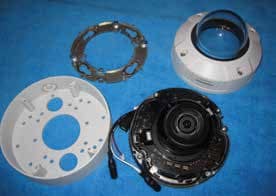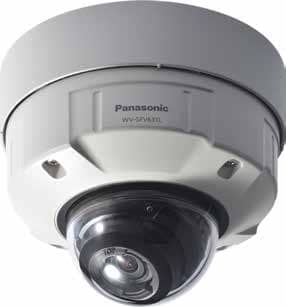The Model WV-SFV631L is part of Panasonic’s 6 Series network cameras. This line is composed of indoor and outdoor fixed dome assemblies in “HD” (1.3 megapixel) or “Full HD” (2.4 megapixel) resolutions. The indoor fixed domes have regular and vandal-resistant housings, while the two outdoor fixed domes both have vandal-resistant enclosures. I was provided the outdoor full HD camera for review, and this model certainly has plenty of tools available for the installer and end user to incorporate into their CCTV systems.
Construction
The first thing I noticed about the IP66-rated Panasonic WVSFV631L was the solid design and feel to the camera assembly. I have seen several camera assemblies over time that claim to be a vandal dome but their overall feel and construction leaves something to be desired. The Panasonic WV-SFV631L certainly doesn’t have that problem with its cast aluminum case and polycarbonate dome. Both of the body sections have close tolerances and the internal seal’s edge has a smooth finish. The camera’s umbilical cords protrude through two sealed openings on the rear of the assembly and the internal dome gasket provides a nice tight seal for the camera’s front cover. The WV-SFV631L is also designed to operate in a wide temperature range (-45⁰ to 122⁰ F). When properly mounted, the enclosure should be able to withstand any weather event.
The WV-SFV631L ships with a ceiling/wall mounting bracket that, once installed, allows the camera assembly to be easily snapped into place and secured with a retaining screw. There is also a raised trim ring that accepts the mounting bracket and is predrilled to mount to six different bolt patterns (I really didn’t know there were that many options for a j-box!). The trim ring has a side opening that allows the easy connection of conduit through the threaded opening and keeps everything neat during the installation.
The camera assembly has a couple of nice features for the field installer that can simplify mounting the unit. First, the camera’s main assembly is clearly marked with “top” and “front” indicators, helpful when orientating the camera from the top of the ladder. Second, the camera’s gimbal assembly has a “top” indicator to also allow the installer to know where the field of view is relative to the camera’s assembly.
Features
The Panasonic WV-SFV631L, like the majority of network cameras today, is designed to be powered via PoE through its RJ-45 network connector. This provides a simple “one-wire” solution for a systems integrator when mounting the device. The camera can also be powered via a separate 12VDC connection through the camera’s umbilical cord, if desired. The WV-SFV631L has the ability to provide two-way audio capabilities through hardwired connections to the two 3.5mm line jacks located on the rear of the camera assembly. This can allow remote conversations to be conducted over the network connection. The dome also has the capability to connect to a total of three hardwired alarm inputs and send alerts back to the system.
The WV-SFV631L also has two built-in slots for micro SD memory cards to allow remote video storage at the camera assembly. The SD slots can be configured to record different occurrences to the respective SD card. For example, one SD card can be tasked to record alarm incidents while the other SD card can be configured to record video during a specified schedule. In addition, one or both cards can be tasked with recording video during a network failure, thus allowing the video server to be able to recover any lost frames from the SD card and maintain a continuous recording stream on the server.
The WV-SFV631L is also equipped with an analog video port, which is indispensable for a field technician. This video output allows a field technician to install the network camera and adjust the field of view with a simple handheld analog monitor. I’d
much rather balance a $100 monitor on top of a ladder than a $1,500 laptop any day.
The WV-SFV631I also has an available exterior sun shade for the outdoor models; this is another indispensable item for those installations where the weather is a constant factor on the camera assemblies. I have seen many a camera in the South (Florida especially) where the camera assembly is still fully operational but the dome has met its match with Mr. Sun and it looks like the camera is underwater. I would highly recommend this option for those installations where the sun is a constant factor.

The WV-SFV631L’s design and construction is solid,
and offers helpful items for the installer in the field.
Setup
The WV-SFV631L ships with a CD containing the programming software, manual and viewing software. I do not like having to use proprietary software for camera access and programing for two reasons. First, I prefer to be able to have a known IP address so I can go directly to the camera with a network connection on my test bench. This makes the initial camera access easy and, if you screw it up, all you have to do is default the camera’s IP address and start over fresh. Second, I hate having to load multiple camera search & configuration programs on my computer. I don’t like loading programs on my computer that I may use once or twice and then have to uninstall them. You should be able to get to a network camera via Internet Explorer (or your Web browser of choice) and make a quick connection.
I decided to see if I could find the camera assembly via a DHCP assignment on my network before I installed all of the included software. I connected the dome to my PoE switch and waited for the unit to power cycle. After a few moments I conducted a network scan and located the camera’s assigned IP address. I discovered I was able to access the camera this way and away I went. Once the camera came up, I tried to access the video stream when (you knew it was coming) I discovered I had to load Panasonic’s viewer software to view the camera’s video stream. I allowed the camera to perform its task and it went out to the Web, downloaded the newest version of Panasonic’s Network Camera View 4S, and then s-l-o-w-l-y ran through the setup. I didn’t time it but it definitely seemed like it took much longer to run through the software installation that usual. Once that was accomplished, I was in to the camera and had a great picture on my laptop.
Testing
Once in to the WV-SFV631L, I worked my way through the dome’s system menus. Programming the product is similar to other IP cameras on the market, as you can imagine. There are the usual settings available to adjust the name, time, date, IP address and other basic system information. One of the features in the WVSFV631L’s menu is the ability to adjust the four H.264 streams and configure them for individual resolution rates. The streams are also designed to incorporate with Panasonic’s UniPher proprietary System LSI platform. The camera can also be programmed to provide JPEG streams for applications that require it, and has built-in video motion detection.
Another feature available on the WV-SFV631L is the ability to adjust the dome’s zoom and focus, and initiate the autofocus feature through its menus. To test this feature, I moved the dome around and centered on several different field of views. Each time the WV-SFV631L zoomed in or out it would perform the autofocus function and provide a sharp image. This feature is one of the best items manufacturers have come up with in recent years. It is so much easier and convenient to be able to remotely adjust IP cameras than to have to play the old “hold the dome up and hope you get the lens adjustment right” game.
The WV-SFV631L is supplied with LED IR technology. When I opened up the dome, I couldn’t tell where the LEDs were. I initially thought maybe my unit didn’t have IR illumination. Once I went through the camera’s settings and testing it, I placed it outside in almost total darkness. The camera’s LEDs kicked in and I was presented with a clear picture that was properly illuminated via the LED IRs. The literature from Panasonic touts the IR illumination and the way it doesn’t bloom the light and cause close objects in the field of view to be “hot” in the picture. The images I observed during my testing confirmed what the literature presented. The unit’s image was very good and the normal hot spots weren’t observed in the images I saw.
Conclusions
The Panasonic WV-SFV631L is a very good network camera. The dome’s design and construction is solid and the attention given to the helpful items for the installer will be greatly appreciated by those in the field. As noted, the proprietary software requirements can be a pain but you can locate the camera without using the software. Viewing will require the software but it appears it does uninstall completely and doesn’t leave anything behind to mess with your computer. The video images from the camera are excellent and the multiple streams are a nice feature.
Verdict
- Features 1 2 3 4 5
- Construction 1 2 3 4 5
- Setup 1 2 3 4 5
- Performance 1 2 3 4 5
- Overall 1 2 3 4 5
First published in the September 2014 issue of Security Sales & Integration magazine.




